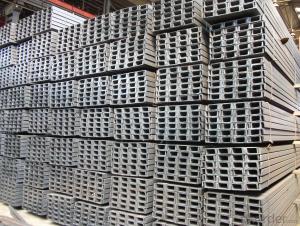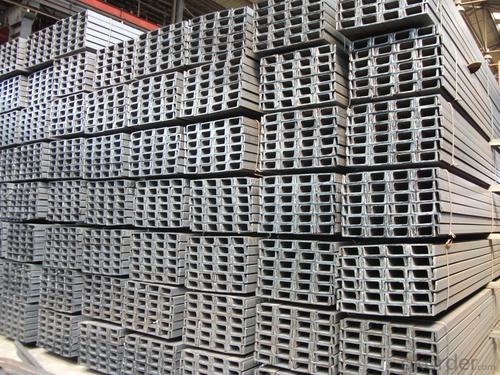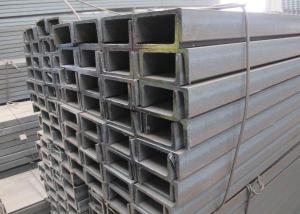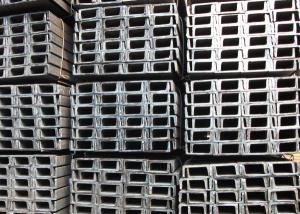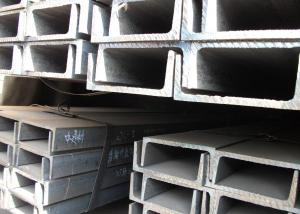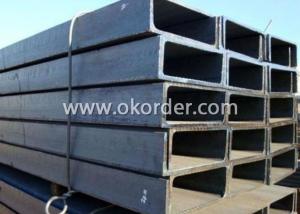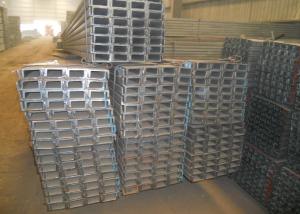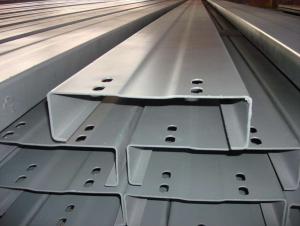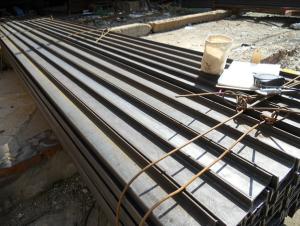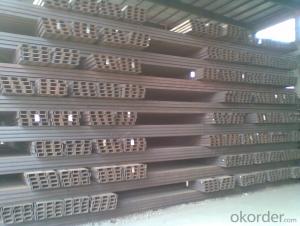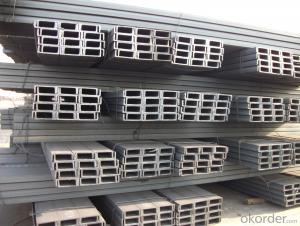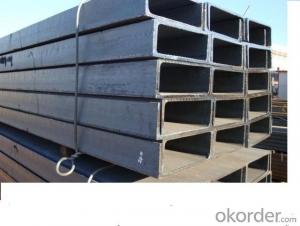High Quality 18# Steel Channel
- Loading Port:
- China Main Port
- Payment Terms:
- TT OR LC
- Min Order Qty:
- -
- Supply Capability:
- -
OKorder Service Pledge
OKorder Financial Service
You Might Also Like
Steel Channel
Standard: GB
Material: Q235
Length: 6m, 12m
Size:
| Size (mm) | Mass (Kg/m) |
| 180*68*7.0 | 20.174 |
| 180*70*9.0 | 23.000 |
The chemical composition of HR Channel Steel according to Q235B is shown in Table-1.
Alloy No | Grade | Element(%) | ||||
C | Mn | S | P | Si | ||
Q235 | B | 0.12-0.20 | 0.3-0.7 | ≦0.045 | ≦0.045 | ≦0.3 |
Table-1
Note: we are able to present our customers relevant SGS test report for chemical composition of HR Channel Steel.
The mechanical property of HR Channel Steel according to Q235B is shown in Table-2
Alloy No | Grade | Yielding Strength Point(Mpa) | |||
Thickness(mm) | |||||
≦16 | >16-40 | >40-60 | >60-100 | ||
≧ | |||||
Q235 | B | 235 | 225 | 215 | 205 |
Table-2
Package & Delivery of MS Channel:
1.The hot rolled channel steel will be packed in bundle with steel wire at each end of every bundle and color marking in order to help the customer to recognize his goods more easily at sight.
2. And the hot rolled channel steel could be loaded into 20ft or 40ft container, or by bulk cargo.If the weight of each bundle reaches more than 3.5 mt, the loading by break bulk cargo should be choosed.When the weight of each bundle reaches less than 3mt, the loading by container should be choosed.
3.As for the transportaion from mill to loading port, the truck will be usually used. And the maximum quantity for each truck is 40mt.
4.All in all, we could do in accordance with customer's request.
*If you would like to get our price, please inform us the size, standard/material and quantity. Thank you very much for your attention.
- Q: Are steel channels suitable for use in underground structures?
- Yes, steel channels are suitable for use in underground structures. Steel channels are known for their strength, durability, and resistance to various environmental factors such as moisture and corrosion. This makes them ideal for use in underground structures where they can provide structural support and ensure the integrity of the construction over time.
- Q: I unit of a shopping center construction project, 4.2 meters high, four floors.Because the first floor is adjacent to the building, the scaffold can not be erectedWe would like to use 20 channel three from 2 to 15 meters, ask how much channel spacing?
- You set the bar spacing 1.5 meters, step distance 1.8, the general parameters know the spacing of the channel.
- Q: What are the different methods of strengthening steel channels against bending?
- There are several methods that can be used to strengthen steel channels against bending: 1. Increasing the channel's cross-sectional area: One way to enhance the strength of a steel channel against bending is to increase its cross-sectional area. This can be achieved by using a thicker channel or by adding additional steel plates or sections to increase the overall area. 2. Using reinforcement plates or stiffeners: By attaching reinforcement plates or stiffeners to the weak areas of the channel, its resistance to bending can be significantly improved. These plates or stiffeners are typically welded to the channel and help distribute the applied loads more evenly, reducing the risk of bending. 3. Adding flanges or lips: Another method is to add flanges or lips to the edges of the channel. These additional sections of steel increase the stiffness of the channel, making it more resistant to bending. 4. Using bracing or truss systems: Bracing or truss systems can be employed to support the steel channel and prevent bending. These systems consist of additional steel members, such as braces or trusses, that are connected to the channel to provide additional support and distribute the applied loads. 5. Heat treatment: Heat treatment processes, such as quenching and tempering, can be used to strengthen the steel channel. These processes involve heating the channel to a specific temperature and then rapidly cooling it to increase its hardness and strength. 6. Cold working: Cold working techniques, such as cold rolling or cold drawing, can also be used to strengthen steel channels against bending. These processes involve deforming the channel at low temperatures, which increases its strength and toughness. It is important to note that the choice of method depends on various factors, including the specific application, the desired level of strength, and the available resources and equipment. Consulting with a structural engineer or steel fabrication expert is recommended to determine the most suitable method for strengthening steel channels against bending in a particular situation.
- Q: What are the different corrosion protection methods for steel channels in marine environments?
- Steel channels in marine environments face a high risk of corrosion due to the presence of saltwater and harsh elements. To protect against corrosion, there are several methods available: 1. Coating: Applying protective coatings, such as epoxy, polyurethane, and zinc-rich paints, creates a barrier between the steel surface and corrosive elements. This prevents direct contact and subsequent corrosion. 2. Cathodic protection: This method utilizes sacrificial anodes or impressed current to safeguard steel channels. Sacrificial anodes made of zinc or aluminum are attached to the steel channels and corrode preferentially, sacrificing themselves to protect the steel. Impressed current systems use an external power source to provide a protective electrical current. 3. Galvanization: Galvanizing steel channels involves coating them with a layer of zinc, which acts as a sacrificial layer. This sacrificial layer corrodes instead of the steel, providing protection against corrosion in marine environments. 4. Stainless steel: Utilizing stainless steel channels is another effective method. Stainless steel contains chromium, which forms a passive oxide layer on the surface, safeguarding against corrosion. It is highly resistant to corrosion in marine environments and commonly used in critical applications. 5. Proper maintenance: Regular inspection, maintenance, and upkeep are crucial to prevent corrosion in steel channels. This includes removing marine growth, repairing coating damage, and ensuring proper drainage and ventilation to minimize exposure to corrosive elements. It is important to consider factors such as the severity of the marine environment, duration of exposure, and expected lifespan of the steel channels when selecting a corrosion protection method. Consulting corrosion engineers or specialists can assist in determining the most suitable protection method for specific marine applications.
- Q: How do steel channels perform in extreme temperature conditions?
- Steel channels perform well in extreme temperature conditions due to their high thermal conductivity and low thermal expansion coefficient. This means that steel channels are able to efficiently transfer heat and cold, allowing them to maintain their structural integrity and stability in extreme temperature environments. Additionally, steel channels have a high melting point, which makes them resistant to deformation or structural failure even at high temperatures. The strength and durability of steel also contribute to its performance in extreme temperature conditions, as it is less likely to warp, bend, or crack under thermal stress. Overall, steel channels are a reliable choice for applications requiring stability, strength, and resistance to extreme temperatures.
- Q: Are steel channels suitable for residential construction?
- Yes, steel channels are suitable for residential construction. They provide strength, durability, and stability to structures, making them an ideal choice for framing, support beams, and other load-bearing applications in residential buildings. Additionally, steel channels offer design flexibility, fire resistance, and are resistant to pests and rot, making them a reliable and efficient option for residential construction.
- Q: What are the different factors to consider when selecting steel channels?
- Some factors to consider when selecting steel channels include the size and weight requirements of the project, the desired strength and durability of the channels, the specific application or industry in which they will be used, the availability and cost of the channels, and any additional features or specifications that may be necessary for the project.
- Q: How do steel channels contribute to the stability of roofing structures?
- Steel channels play a crucial role in enhancing the stability of roofing structures in multiple ways. To begin with, steel channels serve as purlins, which are horizontal beams that offer support and stability to the roof. These purlins are typically positioned perpendicular to the rafters or trusses and securely attached to them, resulting in a robust and rigid framework. By evenly distributing the weight of the roof across the structure, the steel channels prevent excessive deflection and ensure the overall stability of the roofing system. Additionally, steel channels are renowned for their excellent strength-to-weight ratio, allowing them to support heavy loads without adding unnecessary weight to the structure. This is particularly advantageous in roofing structures, as they must bear the weight of various roof materials, such as tiles or metal sheets, as well as any additional loads like snow or wind. The utilization of steel channels enables the construction of lightweight yet sturdy roofs, ultimately enhancing the overall stability of the structure. Moreover, steel channels provide resistance against structural movements and deformations. They effectively counteract sagging or buckling of the roof, which can occur due to continuous exposure to external forces like wind or seismic activity. The inherent rigidity and strength of steel channels make them highly resistant to bending or warping, ensuring that the roof remains stable and secure over an extended period. Furthermore, steel channels offer exceptional durability and longevity to roofing structures. They exhibit resistance to corrosion, rust, and decay, which are common issues faced by roofing materials exposed to the elements. This resistance ensures that the steel channels maintain their structural integrity, allowing the roof to remain stable and functional for an extended duration. Overall, incorporating steel channels within roofing structures significantly contributes to their stability by providing a robust, lightweight, and rigid framework. These channels effectively distribute weight, resist structural movements, and offer durability, thus ensuring a stable and long-lasting roofing system.
- Q: What are the types of channel steels?
- Channel specification, model and theoretical weight table, channel steel is a strip of steel with a cross section. The representation of specifications, such as a*b*c (where a, B, C on behalf of the letters, no other meaning, and the relationship between letters), said waist height is a mm, B mm wide leg channel, channel waist thickness of C mm, or (a/10) # channel. The same height of the channel, if there are several different leg width and waist thickness, also need to add a, B, C on the right side of the model to distinguish, such as 25a#, 25b#, 25c# and so on.
- Q: Can steel channels be used for equipment racks?
- Yes, steel channels can be used for equipment racks. Steel channels are often used in the construction industry for their strength and durability. When used for equipment racks, steel channels provide a sturdy and reliable framework to support heavy equipment. They can be easily customized to fit specific dimensions and can withstand the weight and load of various types of equipment. Additionally, steel channels can be designed with slots or holes to allow for easy installation and mounting of equipment. Overall, steel channels are a popular choice for equipment racks due to their strength, durability, and versatility.
Send your message to us
High Quality 18# Steel Channel
- Loading Port:
- China Main Port
- Payment Terms:
- TT OR LC
- Min Order Qty:
- -
- Supply Capability:
- -
OKorder Service Pledge
OKorder Financial Service
Similar products
Hot products
Hot Searches
Related keywords
